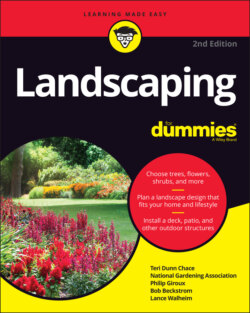Читать книгу Landscaping For Dummies - Lance Walheim - Страница 88
Ramping up — a checklist
ОглавлениеMany structures, such as decks and large shade structures (like pergolas), must meet building-code requirements. Irrigation systems are subject to plumbing codes, and lighting and wiring projects are subject to electrical codes. Observe the following list of construction basics for outdoor projects, and bring in the professionals for some or all parts of the project that aren’t in your wheelhouse:
Investigate regulations. Contact your local building department to find out which regulations apply to your project and whether you need to obtain a permit. Although states or provinces have standardized building codes, municipalities often refine them even further.Your home may also be subject to the guidelines or rules enforced by a neighborhood or homeowners’ association, which may include a design-review process that usually requires submitting a measured drawing (scaled plan), not just a rough sketch.
Draw plans. Work out construction details on paper, not on the job, by making scale drawings (quarter-inch, or small-square metric, graph paper makes this task so much easier). Sometimes elevation drawings are helpful; these drawings show plans from the ground up to illustrate height relationships. Part 1 discusses what to draw.
Require adequate foundations. Structures must be supported on concrete footings, gravel beds, or similar foundations. Designs vary with local climate, soil, and slope conditions, but the basic requirement is to place the weight of a structure on solid ground (below the frost line — the depth to which the ground freezes during winter, which can be 4 feet, 1.2 m, or even deeper) or on a stable, well-drained bed. Also all rot-prone wood must be elevated at least 8 inches (20.3 cm) above grade (aboveground level).
Choose building materials carefully. Wood remains popular, but you have other options. See the section, “About Wood Alternatives,” later in this chapter.
Utilize corrosion-resistant fasteners and hardware. Use nails, screws, and hardware that are galvanized or otherwise treated for outdoor use. For galvanized nails, we recommend HDG (which means hot-dip galvanized). Use fasteners that grip, such as spiral-shank nails or galvanized deck screws, for better holding power. One secret to building long-lasting outdoor structures from wood is to nail, screw, strap, glue, and connect the heck out of ’em!
If you use wood, choose finishes that last. Preservatives (which protect wood from destructive organisms), sealers (which repel moisture), semitransparent stains (light-bodied stains that reveal grain pattern), solid stains (which mask the wood), and paints help wood structures last for years. Some products contain two or more finishes, such as stains that contain a sealer, preservative, and/or ultraviolet-ray blocker. The most effective finishes are those that penetrate the wood, such as water repellents, water-repellent preservatives, and semitransparent stains, and those that are designated specifically for outdoor wood structures, not just for general use.
Manage materials carefully. Estimating, ordering, obtaining, delivering, and storing materials is a major part of construction. Many materials are readily available from home centers, but you may have to locate a masonry yard, concrete supplier, fencing specialist, or similar outlet for others. Discuss delivery fees with suppliers.Plan your job so that you move materials only once by storing them near (6 to 10 feet, 1.8 to 3 m from) the construction site. Stack lumber on a flat, dry, shaded surface, such as a patio or garage floor, to keep it from warping. (Keep lumber off dirt or grass.) Create shelf space to store nails, bolts, screws, and similar hardware. Store bags of cement or mortar mix out of the weather. Use a wheelbarrow or arrange for a helper to move sand, gravel, and masonry materials from the street to your yard. Avoid storing materials and equipment under a tree (within a tree canopy area) because the resulting soil and root compaction can lead to tree death, if not right away, in a couple of years.
Have a plan for debris. Figure out ahead of time where to haul your debris in the likely event that regular trash services won’t pick it up. To make disposal easier, separate trash, clean fill, toxins, and reusable scraps. Arrange for a disposal service to haul everything away, if you can’t do so yourself.
